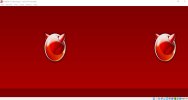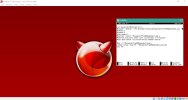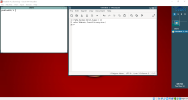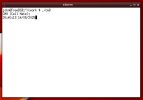I am growing quite fond of sh and command driven computing lately.
...told you so

You were open minded, gave it a shot, learned, and learned to love it.

(And did it faster than me

)
Welcome to the world of unixstyle computering. Welcome to the power

i know, i am not being clear in my description. The reason why i cannot quite describe what i desire to have as a "desktop" is because it does not exist.
There are 3 options:
A) Look what others have (you will find a lot of examples and config files for WM if you search for it), and if you have use for it.
B) Create things yourself, by analyzing your working style (watch yourself from a higher abstraction level), think of a tool how this could a help, and do it yourself.
But I dare say almost all useful things are in one way or the other already part of on or the other DE.
The issue I have with DEs is not they don't provide useful things, but they provide things are useless or even annoying to me I neither want, nor need, but cannot be removed/switched off.
C) Maybe you don't need it at all. (But simply don't know yet

)
My idea is to have a blank desktop with an app finder, keyboard switcher, a clock, a calendar, a terminal launcher, a browser launcher and a file manager launcher.
Besides I don't know what you mean with a 'keyboard switcher', almost everything is provided by every DE/WM in basic config, or at least quickly done.
E.g. you'll find a lot of clocks in
/usr/ports/x11-clocks
I use good old xclock. Worx. No fiddle-faddle. Runs on every X-server, can not only be started with
-strftime (actually I run two clocks: one for the date, one for the time) but with a selected font, size, fore- and background
color (see xlock's man page.)
For terminal starts I almost never use the icon anymore, but have several keybindings for different terminal starts, such as "start me a windowless full screen terminal on my main monitor" or "gimme 3 terminals, two splitted 60% 40% on main and one full screen on the second left one, starting each in directory /home/production/..."
I run xterm. I tried several others, but always got back to good, old xterm. Others bring lots of ...things, I don't use while I'm in the shell. But of course that's personal taste.
File managers are kind of a special topic of their own, since I don't have none installed anymore.
The more I got into shell usage the more I disarmed my GUI.
(The last ones I used were:
catseye, sunflower (seems not to exist anymore), and
filerunner, looks old and needs a bit to get used to its default usage, but it's the m
ost powerful filemanager I knew, and
very configurable [but not as powerful and configurable as the shell. No filemanager is.

(
scripts (side is not maintained anymore, and there are many others, but still useful))
But, however, as some one who just started to get the hang of shell usage, you might think of if it's really that useful to bring much effort into configuring your perfect GUI by the start.
You already started to figure out yourself:
I only enter xorg whenever i need to do things that i cannot do in the login shell
Think of the GUI (WM) primarily more as kind of a beautiful way to provide terminals for the shell usage.
Using the shell on your DE/WM instead of the login shell comes with several benefits:
You can have several terminals on the same screen at the same time, individually adapt size for a certain situation, have more choices with fonts, and sizes, easier to scroll,...and many other things.
Pick a configurable WM, start with some very basic things (you already defined all what one really needs - almost all of the rest is fiddle-faddle), and add only what you actually need, when you really need it.
As
hruodr already said between the lines:
Your WM/DE grows and changes over time, becomes more individually tailored. So I wouldn't spend too much time into configuring the perfect one from the start.
After all: Configuring the machine is not the main task to be done.
What the thread was originally started for brings every WM/DE in its vanilla version already:
a small program which will allow me to launch a few select apps with icons.
That was the main menu (left mouse button on desktop background in fvwm):
(just as an example; I quickly picked one from the internet; can look better (
I simply don't know how to do a screenshot with the menu open.here we go.))
Any WM/DE is (shall be) capable to configure this menu completely to your own whishes.
Example from my ~/.fvwm/config (other WM work similar):
Code:
...
+ "&Firefox%$[infostore.icons]/Firefox_16.png%" Exec exec firefox
...
You need to grab a picture from the internet (there are free icon databases) such as
icon-Icons.com
And voilá, there it is, your icon you click on to start an app.
I love this concept: type a few letters and click on the program that you want.
Well, not 'clicking at', but if your hands already are on the keyboard why not just hit 'return'?
That's shell usage again: type a few letters and hit 'autocompletion' (tab) to get a list of all executables available on your machine matching those letters.
You can start every app from the shell (under unix[like] that's the common way; GUI is extra.)





